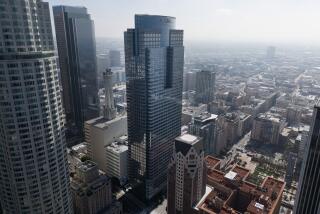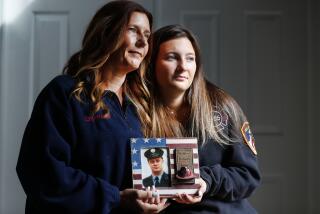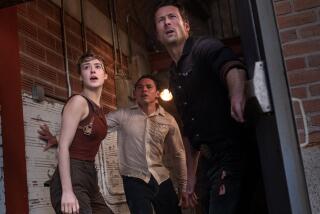Icons of the American Dream Crash Down
- Share via
At dawn, they were two of the world’s tallest buildings. By noon, they were a smoking ruin.
The towering twin skyscrapers that once comprised New York’s storied World Trade Center were in one sense the world’s tallest cornerstones.
The towers were the symbols upon which the preeminence of the American economy was built, emblems of a resurgent confidence that had extended the reach of market capitalism across a continent and around the globe.
Before the morning was over, the rubble that had been the World Trade Center had come to represent a fierce return on America’s investment.
Jon Magnuson, chairman and chief executive officer of Skilling Ward Magnuson Barkshire, the structural engineering company that designed the World Trade Center’s structure, said nothing could have prepared the buildings for today’s assault.
“It depends on what somebody tries to throw at the building. Obviously, they threw too much.”
At 1,362 feet and 1,368 feet respectively, the towers were planned to exceed the elevation of the Empire State Building by 100 feet. If their 316-foot antennas were counted, they topped even the 1,483-foot Petronas Towers in Kuala Lumpur, Malaysia.
The buildings housed about 55,000 workers employed by approximately 350 firms, including the executive offices of the New York Stock Exchange and leading investment, law and accounting firms. Counting those passing through the buildings to transact business, their population during working hours routinely exceeded 100,000 people.
The World Trade Center was New York’s most frequently purchased postcard image.
The towers were the centerpiece of an urban renewal project intended to revitalize lower Manhattan. Construction began in 1966 and the towers opened four years later, in 1970. The architect was the late Minoru Yamasaki, who also designed the Century Plaza Towers in Los Angeles. The twin 110-story towers cost their owners, the Port Authorities of New York and New Jersey, $350 million at the time. Last February, they were leased to a Paramus, N.J.-based real estate firm for $3.25 billion, the largest such deal in history.
The towers were so tall that they swayed by up to 11 inches in a strong wind. In fact, buildings of the Trade Center’s height pose such challenges for engineers that they developed a new system of construction that places major supporting elements in the outer portions of the building to increase stability. Traditionally, such elements have been placed in the building’s core around elevators and restrooms.
At the time of the towers’ construction, this so-called “tubular skyscraper” scheme was hailed as the key that would push the world’s buildings to elevations undreamed of by previous generations.
The project destroyed 16 acres of residential buildings in lower Manhattan and ultimately added 12 million feet of office space to the city’s total. Humans were not the only New Yorkers whose lives were disrupted; the flight patterns of migrating birds were blocked by the towers and, for years afterward, they crashed into the buildings’ upper stories and fell dead to the plaza below.
The 1.2 million cubic yards of earth and rock ripped from the site were dumped into the Hudson River and became the foundation of the Battery Park City residential and commercial development, which netted the Port Authority an additional $90 million.
Such superlatives, along with the buildings’ symbolic presence, made them a magnet for pranksters, publicity-seekers and, ultimately, international terrorists. A deadly 1993 car bomb blast in the towers’ 16-acre subbasement tore a 60-by-100-foot hole, but did not compromise the buildings’ structural integrity. Six men ultimately were convicted for the 1993 bombing, which killed six and injured more than 1,000.
A fully loaded Boeing 767 weighs approximately 200 tons. It can fly at speeds of approximately 500 mph.
Magnuson said that it appeared that the buildings withstood the initial impact of the crashes. The real damage was done by subsequent explosions and fire, he said. The towers’ exterior walls were made up of a tube structure, 51 columns per side, spaced 3 feet, 3 inches apart.
“What structural engineers look for is redundancy. If one system fails, there’s always another to back it up. This was designed with a very redundant system,” Magnuson said.
“It did the first part of its job in resisting this kind of a load. The buildings withstood the initial impact. The subsequent fires caused the collapse. What happens in a fire is steel at 1,500, 1,600 degrees Fahrenheit, steel loses its strength. Then it just collapses.”
In effect, it melts.
“Two things are supposed to counter that: the sprinklers, and all of the steel members are covered with insulation designed to provide a three- to four- hour protection. I’m uncertain the sprinklers worked, but even if they did, with that amount of jet fuel I’m sure the temperatures were well above what we designed for.
“Buildings are designed thinking of internally generated heat. Nobody anticipates putting jet fuel in a building. If you had to build buildings to withstand this sort of event, you wouldn’t be able to build any buildings,” he added.
Angus Kress Gillespie, professor of American studies at Rutgers and author of “Twin Towers,” recently noted that New Yorkers and critics initially regarded the buildings as “banal, boring and unimaginative.” Over the years, however, New Yorkers and others were won over by the structures’ monumental presence.
If you were to treat them as poetry, he said recently, they “stand for capitalism, for free trade, for private enterprise and, by extension, the American dream.”
And, as the smoke billowed through the Indian summer air today, the damage was not only physical, but spiritual.
(BEGIN TEXT OF INFOBOX / INFOGRAPHIC)
Attack from the Skies
The planes believed to be involved in Tuesday morning’s attacks:
American Flight 11: Boeing 767 from Boston bound for L.A. with 81 passengers, hits world trade center.
United Flight 175: Boeing 767 from Boston bound for L.A., carried 56 passengers, 2 pilots, 7 crew.
American Flight 77: Boeing 757 from Washington Dullesbound for L.A. with 58 passengers aboard.
United Flight 93: Boeing 757 from Newark, N.J., to San Francisco, with 45 passengers, crashes 80 miles SE of Pittsburgh.
--- UNPUBLISHED NOTE ---
This story was published this afternoon as part of a special 8-page extra edition wrap focusing on today’s tragic events. Entitled “Terrorism Hits the U.S.,” the wrap focused on the most important events of the day, the history of World Trade Center, terrorism and other safety concerns. It wrapped today’s second daily and was distributed to major single copy retailers and high traffic commuter areas by early afternoon.
--- END NOTE ---
More to Read
Inside the business of entertainment
The Wide Shot brings you news, analysis and insights on everything from streaming wars to production — and what it all means for the future.
You may occasionally receive promotional content from the Los Angeles Times.










